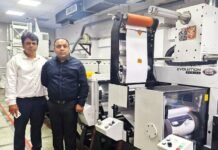Mumbai-based Printmann Offset has made a mark in servicing the Indian pharmaceutical industry’s packaging needs for many years now and in the process it has achieved remarkable success. The company currently operates four verticals catering to the pharmaceutical industry: cartons, leaflets (inserts and outserts), self-adhesive labels and foils. The first three verticals operate under Printmann Offset while the foils business comes under Printmann Foils. Printmann Offset’s flagship plant is in Navi Mumbai while operations also take place at their Lower Parel unit, albeit at a smaller scale. Printmann Foils, meanwhile, operates from a totally different plant located in Vasai.
US FDA woes
 The financial year 2017-2018 was somewhat of a year of disruptions for the Indian industry but Printmann Offset still managed a growth of 9% in the year, which is a respectable achievement. Although, the most talked about and analysed disruptors last year were demonetization and advent of GST; for Printmann Offset which only caters to the pharmaceutical industry, these two events were minor aberrations. The real disruptor, whose discussion was confined to business channels and financial papers, for the pharmaceutical industry, was the various regulatory issues raised by US FDA, which plagued some of the biggest pharmaceutical firms in India.
The financial year 2017-2018 was somewhat of a year of disruptions for the Indian industry but Printmann Offset still managed a growth of 9% in the year, which is a respectable achievement. Although, the most talked about and analysed disruptors last year were demonetization and advent of GST; for Printmann Offset which only caters to the pharmaceutical industry, these two events were minor aberrations. The real disruptor, whose discussion was confined to business channels and financial papers, for the pharmaceutical industry, was the various regulatory issues raised by US FDA, which plagued some of the biggest pharmaceutical firms in India.
“To be honest we never undertook substantial transactions in cash anyway, so demonetization was not an issue for us. As for GST, we feel it’s a positive development as we can now focus on business and not worry about taxes. So, for Printmann, it was the regulatory issues raised by US FDA that really affected us as our exposure to these regulated markets is substantial,” says Ankit Tanna, director, Printmann Offset.
Typically, the US FDA issues a form 483 to pharmaceutical companies if it spots any condition that in their judgment may constitute violations of the US Food Drug and Cosmetic Act and related Acts during inspections. Until these conditions are not met, or there are negative observations by US FDA, these pharmaceutical companies cannot export to the US. Since, in recent years there has been spurt in the negative observations during plant inspections for approvals as well as issue of warning letters, many Indian pharmaceutical companies were negatively affected which had an adverse impact on companies like Printmaan Offset, who service some of the leading drug companies in India.
However, Tejas Tanna, another director of Printmann Offset, feels the worst is behind for the pharmaceutical industry and the next few years are expected to be extremely good for which Printmann Offset has been preparing for during the whole of last year.
Investing during a bear market
Although last year was not such a great year for the pharmaceutical industry, what Tejas Tanna calls a bear phase, yet Printmann Offset invested in some of the state-of-the-art machinery in its cartons as well as its labels division. Early last year, the company bought its second Bobst Expertfold folder-gluer with Accubraille. Apart from two Expertfolds, Printmann Offset has two Bobst Novacut 106 die-cutters on its shop floor as well. The company has a long relationship with Bobst as it first bought a Novacut almost a decade ago.
“Our relationship with Bobst goes back a long way and we have been really satisfied with this relationship. Bobst machines are sturdy, their service back-up is excellent and dealing with them is hassle free,” says Tejas Tanna.
Ankit Tanna says, “I believe once your printing process is over, the jobs should reach your customers as soon as possible and that can happen only if your converting section is flawless. Bobst solutions makes that happen for us.”
Some other important investments that the company made last year were: a sample maker from Advanced Graphic Systems and a stripping and blanking machine from Autoprint, both during Pamex 2017. The company also bought a Lombardi narrow-web flexo press last year for its labels division. And during the first half of April 2018, Printmann Offset commissioned a brand-new Heidelberg press for printing outserts.
“The whole idea for going for these investments during a so-called bear phase was to prepare ourselves for the next round of growth that we expect to see in the next few years,” says Ankit Tanna.
Printmann Offset currently uses two Mitsubishi presses for carton printing and plans are afoot to replace both one by one with new presses in the next one year or so. “The replacement will not happen immediately, but we are planning to replace our two Mitsubishi presses with new presses one by one,” shares Tejas Tanna.
Diversifying into food sector
Printmann Offset has developed solid expertise in servicing the packaging needs of the pharmaceutical industry, which the company now wants to leverage to diversify into the food packaging sector. The company has already made the first move and has got a BRC certification.
“The final diversification is still some time away, but the process has started rolling. However, this will not affect our pharmaceutical clients in anyway. In fact, apart from leaflets, all our three verticals—cartons, labels and foils—will be used to service the packaging needs of the food industry,” says Tejas Tanna.
“We believe the expertise that we have acquired working with the pharmaceutical industry, especially when it comes to regulation, will come in handy when working with the food industry as the latter is also witnessing much tighter regulations in India which will only tighten further as we move forward,” says Ankit Tanna.
A concrete decision on this diversification move is likely to come by the end of the 2018-2019 financial year and the company may have to set up a new facility. The likely shape of Printmann Offset’s operations post diversification into food sector will be that of carton vertical functioning under one roof and label operations under one roof, unlike current operations where both carton and labels divisions are functioning under one roof at Navi Mumbai plant.
“Since we made some big investments in last financial year, this year we want to consolidate. So, any firm decision pertaining to our diversifications into food sector is expected to come by end of this fiscal year. And actual investment into physical infrastructure is expected in 2019-2020 financial year,” concludes Tejas Tanna.











